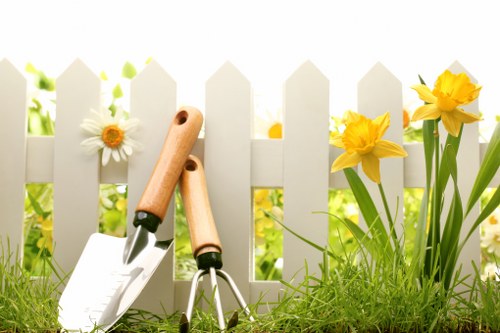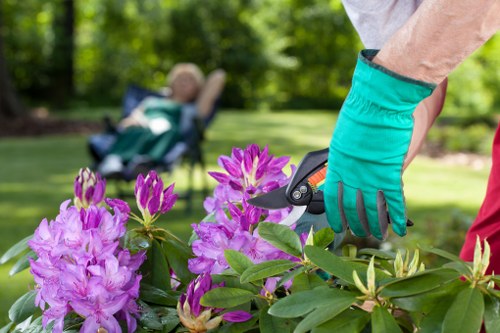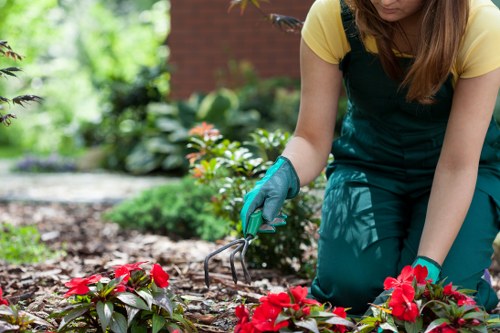Tree Lopping and Removal in Poplar
Introduction to Poplar Tree Lopping

Poplar trees are known for their rapid growth and elegant appearance, making them a popular choice for landscaping and providing shade. However, like all trees, they require proper maintenance to ensure their health and safety. Tree lopping and removal are essential practices to manage the size and structure of poplar trees, preventing potential hazards and maintaining the aesthetic value of your property.
Tree lopping involves the selective pruning of branches to control growth, improve shape, and remove dead or diseased limbs. When done correctly, it can enhance the tree's health and longevity. On the other hand, tree removal becomes necessary when a tree poses significant risks due to structural weaknesses, disease, or environmental factors.
In this article, we will explore the intricacies of tree lopping and removal specifically for poplar trees, providing you with comprehensive insights to make informed decisions about your tree care needs.
Understanding Poplar Trees

Poplar trees, belonging to the genus Populus, are deciduous trees known for their tall stature and distinct leaf shape. They thrive in various climates and soil types, making them a versatile choice for many landscapes. Understanding the biology and growth patterns of poplar trees is crucial for effective maintenance.
Poplars are fast-growing, often reaching heights of 40 to 80 feet within a few decades. Their rapid growth is accompanied by relatively weak wood, making them susceptible to storm damage and breakage if not properly managed. Additionally, poplars have extensive root systems that can interfere with nearby structures and underground utilities.
Recognizing these characteristics helps in planning appropriate tree lopping and removal strategies to ensure the health of the tree and the safety of your property.
Why Lopping and Removal May Be Necessary

There are several reasons why tree lopping or removal might be necessary for poplar trees. Identifying the need early can prevent minor issues from escalating into major problems.
Health Concerns
- Disease: Poplar trees can be susceptible to diseases such as poplar canker, which can weaken the tree and make it prone to breakage.
- Pest Infestations: Insects like poplar borer and aphids can damage the tree's structure and leaves.
- Decay: Fungal infections can cause decay in the trunk and branches, compromising the tree's integrity.
Safety Hazards
- Structural Weakness: Overgrown or improperly maintained branches can fall, posing risks to people and property.
- Interference with Utilities: Large branches can interfere with power lines, causing outages or safety issues.
- Obstructions: Trees blocking pathways or views can be both a nuisance and a safety concern.
Aesthetic and Property Value
- Unsightly Growth: Uncontrolled growth can lead to an unattractive appearance.
- Property Damage: Roots can damage sidewalks, driveways, and foundations if not properly managed.
- Reduced Light: Dense foliage can limit sunlight for other plants and living spaces.
Tree Lopping Techniques for Poplar Trees

Effective tree lopping requires knowledge of proper techniques to ensure the health of the poplar tree and the safety of the surrounding area. Here are some common methods used in the lopping process:
Pruning
Pruning involves removing specific branches to control growth and improve the tree's structure. For poplar trees, this typically includes:
- Dead or Diseased Branches: Eliminating these prevents the spread of disease and reduces the risk of falling limbs.
- Crossing Branches: Removing branches that cross or rub against each other to prevent damage.
- Water Sprouts: Cutting off vertical shoots that drain energy from the tree.
Thinning
Thinning involves selectively removing branches to increase light penetration and air circulation within the canopy. This helps in reducing the overall density of the tree, promoting healthier growth.
Heading Cuts
Heading cuts are used to reduce the length of a branch, encouraging the growth of lateral branches. While this method can help shape the tree, it should be used sparingly as excessive heading can stress the tree.
Crown Reduction
Crown reduction involves cutting back the main branches to decrease the tree's height or spread. This technique is useful in managing the tree's size to prevent interference with structures or power lines.
Best Practices for Tree Lopping
To ensure effective and safe tree lopping, follow these best practices:
- Use Proper Tools: Ensure all tools are sharp and appropriate for the size of branches being cut.
- Follow the 3-Cut Method: This technique prevents branch tearing by making sequential cuts before removing the branch.
- Maintain Tree Health: Avoid excessive pruning which can stress the tree and make it more susceptible to diseases.
- Safety First: Always wear protective gear and consider hiring professionals for larger jobs.
Adhering to these practices will help maintain the structural integrity and health of your poplar trees.
When to Consider Tree Removal

While tree lopping can address many issues, there are situations where complete tree removal becomes necessary. Knowing when to remove a poplar tree can prevent further complications and ensure the safety of your property.
Severe Structural Damage
If a poplar tree has significant structural damage due to storms, disease, or decay, it may pose a danger if left standing. Cracked trunks, large dead branches, or leaning structures are indicators that removal is the safest option.
Unmanageable Size
Poplar trees can grow quite large and may become unmanageable if not properly maintained. If the tree's size interferes with buildings, power lines, or other structures and cannot be adequately controlled through pruning, removal is advisable.
Root Damage
Extensive root systems can damage sidewalks, driveways, and foundations. If roots are causing significant structural issues, removing the tree may be the only solution.
Obstruction of Utilities
Branches that consistently interfere with power lines or other utilities can be hazardous. When repeated pruning is not effective in resolving the issue, tree removal may be necessary.
Toxicity and Allergies
In rare cases, poplar trees can cause allergic reactions or contain toxic properties that make their presence undesirable. In such situations, removal ensures the well-being of residents.
Assessing the Need for Removal
Before deciding to remove a poplar tree, consider the following steps:
- Professional Assessment: Hire an arborist to evaluate the tree's health and structural integrity.
- Cost-Benefit Analysis: Weigh the costs of removal against the benefits of maintaining the tree.
- Alternative Solutions: Explore other options such as cabling, bracing, or partial removal to address specific issues.
Making an informed decision will help you choose the best course of action for your property.
Choosing the Right Professionals
When it comes to tree lopping and removal, especially for poplar trees, hiring the right professionals is crucial. Experienced arborists can ensure the job is done safely and effectively, minimizing risks and maximizing the tree's health.
Qualifications to Look For
- Certification: Ensure the arborist is certified by relevant organizations such as the International Society of Arboriculture (ISA).
- Insurance: Verify that the company has proper liability insurance and worker's compensation.
- Experience: Look for professionals with extensive experience in poplar tree maintenance and removal.
- Reputation: Check reviews, testimonials, and ask for references to gauge the company's reliability and quality of work.
Services Offered
A reputable tree care company should offer a range of services, including:
- Tree Lopping and Pruning
- Tree Removal and Stump Grinding
- Inspection and Health Assessments
- Emergency Storm Damage Services
Getting Estimates
Obtaining multiple quotes allows you to compare prices and services. Ensure that each estimate includes a detailed breakdown of costs and the scope of work to avoid unexpected expenses.
Questions to Ask Potential Contractors
- What is your experience with poplar tree lopping and removal?
- Are you licensed and insured?
- Can you provide references from previous clients?
- What safety measures do you implement during the job?
- How do you handle waste disposal and cleanup?
Asking these questions will help you select a competent and trustworthy professional for your tree care needs.
The Tree Removal Process
Tree removal is a complex process that requires careful planning and execution. Understanding the steps involved can help you prepare and ensure a smooth removal process for your poplar tree.
Initial Assessment
The first step involves a thorough assessment of the tree's condition and its surroundings. The arborist will evaluate factors such as the tree's health, structural integrity, location, and proximity to buildings or power lines.
Obtaining Permits
Depending on local regulations, you may need permits for tree removal, especially if the tree is protected or located in a restricted area. The tree care professional can assist in navigating the permitting process.
Planning the Removal
- Access Routes: Determining the safest route for bringing in equipment and removing the tree.
- Equipment Selection: Choosing the appropriate tools and machinery based on the tree's size and location.
- Safety Measures: Implementing protocols to protect workers and property during the removal process.
Executing the Removal
The actual removal involves several steps:
- Pruning: Removing smaller branches to make the trunk accessible.
- Sectioning: Cutting the tree into manageable sections using the three-cut method to prevent branch tearing.
- Lowering Sections: Carefully lowering each section to the ground using ropes and harnesses.
- Debris Removal: Clearing away branches, leaves, and the stump to leave the area clean.
Stump Removal
After the tree is down, the stump removal process begins. Options include:
- Grinding: Using a stump grinder to reduce the stump to mulch.
- Excavation: Physically removing the stump and its roots.
- Chemical Treatment: Applying substances to accelerate the decomposition of the stump.
Post-Removal Cleanup
Ensuring the area is free of debris and hazards is essential. This includes:
- Removing all branches and leaves.
- Grinding the stump to prevent future growth.
- Restoring the landscape to its original state or preparing it for new plantings.
A thorough cleanup ensures safety and maintains the visual appeal of your property.
Cost Factors in Tree Lopping and Removal
The cost of tree lopping and removal can vary based on several factors. Understanding these can help you budget for the service effectively.
Tree Size and Height
Larger and taller trees typically require more labor, time, and specialized equipment, increasing the overall cost. The diameter of the trunk and the extent of the canopy also play significant roles in pricing.
Location and Accessibility
Trees located in hard-to-reach areas, near structures, or in restricted spaces may require additional effort and equipment, impacting the cost. Urban locations with limited access can be more expensive to service.
Health and Condition of the Tree
Diseased or damaged trees may need specialized care, such as treating infections or handling unstable branches, which can add to the cost.
Removal Complexity
If the tree has overgrown branches, extensive root systems, or if it's intertwined with other vegetation, the removal process becomes more complex and costly.
Geographical Location
Prices can vary based on regional labor rates, availability of services, and local regulations. Urban areas may have higher costs compared to rural locations.
Additional Costs to Consider
- Permit Fees: Costs associated with obtaining necessary permits for removal.
- Stump Grinding: Additional charges for grinding or removing the stump.
- Cleanup Services: Fees for debris removal and site restoration.
- Emergency Services: Higher rates for urgent or after-hours services.
It's advisable to obtain detailed estimates and discuss all potential costs with the service provider before proceeding.
Benefits of Professional Tree Services
Opting for professional tree lopping and removal services offers numerous advantages, ensuring the job is done efficiently and safely.
Safety
Tree work can be dangerous, especially with large poplar trees. Professionals are trained in safety protocols, reducing the risk of accidents and injuries.
Expertise and Knowledge
Certified arborists possess the expertise to assess tree health, determine the appropriate maintenance techniques, and execute them effectively.
Proper Equipment
Professional tree services have access to specialized tools and machinery required for safe and efficient tree lopping and removal.
Time and Efficiency
Experienced teams can complete the job more quickly and effectively than DIY methods, minimizing disruption to your property.
Compliance with Regulations
Professionals are familiar with local tree ordinances and can ensure that removal activities comply with legal requirements, avoiding potential fines.
Environmental Considerations
Professional tree services often practice sustainable methods, such as recycling wood and minimizing environmental impact during removal and disposal.
- Recycling Wood: Utilizing wood for mulch or other purposes reduces waste.
- Minimizing Soil Disruption: Careful removal techniques prevent unnecessary disturbance to the surrounding environment.
- Protecting Nearby Vegetation: Professionals take measures to safeguard other plants and trees during the removal process.
Choosing a professional service ensures that tree lopping and removal are conducted responsibly and sustainably.
Environmental Impact of Tree Removal
While tree removal can sometimes be necessary, it's important to consider its environmental implications. Proper planning and responsible practices can mitigate negative effects.
Loss of Habitat
Trees provide essential habitats for various wildlife species. Removing a poplar tree can disrupt local ecosystems, affecting birds, insects, and other organisms that depend on it.
Carbon Sequestration
Trees play a vital role in capturing carbon dioxide from the atmosphere. Removing them reduces the capacity for carbon sequestration, contributing to increased greenhouse gas levels.
Soil Erosion
Tree roots help stabilize the soil, preventing erosion. Without the tree's root system, the soil may become more susceptible to washouts and other forms of erosion.
Mitigating Environmental Impact
To minimize the environmental footprint of tree removal, consider the following strategies:
- Replanting: Planting a new tree can compensate for the lost one, maintaining ecological balance.
- Using Sustainable Practices: Opt for services that recycle wood and manage waste responsibly.
- Preserving Biodiversity: Leave some branches or parts of the tree to support wildlife habitats.
Alternative Solutions
Before deciding on removal, explore other options that may preserve the tree and its environmental benefits:
- Salvage Operations: Retaining parts of the tree while removing others to maintain some of its ecological functions.
- Structural Supports: Adding supports like braces or cables to strengthen the tree without removing it.
- Pest and Disease Management: Treating specific issues to improve the tree's health and stability.
Carefully considering these alternatives can help balance the need for tree removal with environmental stewardship.
Maintaining Poplar Trees Post-Lopping
Proper maintenance after tree lopping is crucial to ensure the continued health and stability of poplar trees. Implementing the right care practices can prolong the tree's lifespan and prevent future issues.
Regular Inspections
Conduct routine inspections to monitor the tree's health and identify any signs of stress, disease, or structural weaknesses early on.
Proper Watering
Ensure the tree receives adequate water, especially during dry periods. Poplar trees have high water requirements, and consistent watering supports their rapid growth.
Fertilization
Apply appropriate fertilizers to provide essential nutrients, promoting healthy growth and strengthening the tree against pests and diseases.
Mulching
Apply mulch around the base of the tree to retain soil moisture, regulate temperature, and suppress weed growth.
Continued Pruning
Maintain a regular pruning schedule to control growth, remove any new dead or diseased branches, and preserve the tree's shape.
Monitoring for Pests and Diseases
Stay vigilant in observing any signs of pest infestations or disease symptoms. Early detection allows for prompt treatment, preventing minor issues from becoming severe problems.
- Pest Control: Use environmentally friendly pest control methods to manage infestations without harming beneficial insects.
- Disease Management: Implement appropriate treatments to address fungal or bacterial infections affecting the tree.
- Stress Prevention: Avoid practices that can stress the tree, such as over-pruning or improper watering.
Ongoing maintenance ensures that your poplar trees remain healthy, safe, and visually appealing for years to come.
Conclusion
Managing poplar trees through tree lopping and removal is a vital aspect of maintaining a safe and beautiful landscape. Understanding when and how to perform these services ensures the health of the trees and the safety of your property.
Whether you need to control the growth of a poplar tree, address health issues, or remove a hazardous tree, professional arborists provide the expertise and tools necessary to carry out the job effectively. By choosing the right tree care services and adhering to best practices, you can preserve the natural beauty and ecological benefits that poplar trees offer.
Don’t wait until a minor issue becomes a major problem. Contact us today to schedule a consultation and ensure your poplar trees receive the care they deserve.
Frequently Asked Questions
How often should poplar trees be lopped?
Poplar trees should be pruned at least once a year to maintain their shape, remove dead or diseased branches, and promote healthy growth.
What are the signs that a poplar tree needs to be removed?
Signs include significant structural damage, presence of large dead branches, disease or pest infestations, excessive leaning, and interference with utilities or structures.
Can I lop my poplar tree myself?
While minor pruning can be done by homeowners, professional lopping is recommended for larger trees or when removal is necessary to ensure safety and effectiveness.
What happens to the tree after removal?
After removal, the wood can be recycled into mulch or wood chips, or disposed of according to local regulations. The stump can be ground down or removed entirely, depending on your preference and needs.
How can I prevent future issues with my poplar trees?
Regular maintenance, including annual pruning, proper watering, fertilization, and monitoring for pests and diseases, can help prevent future issues and maintain the health of your poplar trees.
Book Your Poplar Tree Service Now
Ensure the longevity and safety of your poplar trees by scheduling professional tree lopping and removal services. Our team of certified arborists is ready to assist you with all your tree care needs.
Book your service now and experience top-notch tree care that enhances the beauty and safety of your property.